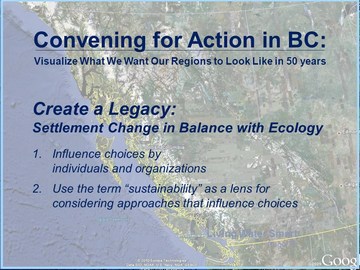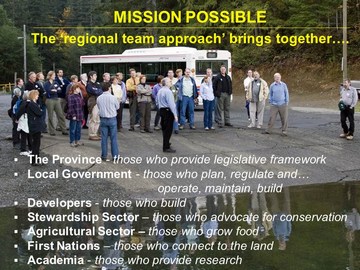Salish Sea Ecosystem Conference showcases “Mission Possible: Convening for Action in British Columbia”
Note to Reader:
The Salish Sea Ecosystem Conference is the largest, most comprehensive scientific research and policy conference in the Georgia Basin – Puget Sound bio-region. Co-hosted by Environment Canada and the Puget Sound Partnership, the 2011 conference presents the latest scientific information on the state of the ecosystem.
The conference also shares information on recent management actions and best practices to protect and restore the Salish Sea Ecosystem. Through these dialogues, the conference emphasizes the importance of collaboration among scientists and policymakers to solve complex environmental issues that cross political borders.
“We are approaching maximum capacity at the venue,” reports Jennie Wang of Environment Canada. She advises that early registration has exceeded expectations; and urges those who have not yet registered to do so NOW.
For details of the conference program, AND TO REGISTER, click on Salish Sea Ecosystem Conference. This cross-border signature event provides a platform to showcase what is being accomplished through the Convening for Action in British Columbia initiative. The article below foreshadows what to expect in a forum session titled Mission Possible.

Land Use and Growth
“The opening plenary comprises a Local Government Leaders Panel. They will speak to ‘Land Use and Growth’. Our Mission Possible forum session follows the plenary. We are showcasing how a ‘convening for action’ philosophy has  taken root in BC,” states Tim Pringle, President of the Partnership for Water Sustainability in British Columbia.
taken root in BC,” states Tim Pringle, President of the Partnership for Water Sustainability in British Columbia.
“A decade ago, the Province of British Columbia made a conscious decision to follow an educational rather than prescriptive path to change practices for the use and conservation of land and water. Practical research and new tools are now enabling engineers, planners and other disciplines to do business differently. It is about turning the whole game around to collaborate as regional teams and design with nature.”
To Learn More:
Click on Designing with Nature in British Columbia — A provincial goal is settlement change that is in balance with ecology. Use of the phrase ‘design with nature’ is facilitating a paradigm-shift in the local government setting.
Mission Possible
Released in June 2010, Beyond the Guidebook 2010: Implementing a New Culture for Urban Watershed Protection and Restoration in British Columbia describes how a ‘convening for action’ philosophy has taken root in British Columbia.
“Bringing together local government practitioners in neutral forums has enabled implementers to collaborate as regional teams. Their action-oriented focus has resulted in ‘how to do it’ examples of rainwater management and green infrastructure that help decision-makers visualize what ‘design with nature’ policy goals look like on the ground,” elaborates Kim Stephens, Partnership Executive  Director.
Director.
“Systemic change is possible, as the case study experience in Beyond the Guidebook 2010 demonstrates, even in the complicated sphere of planning for use and conservation of land. It requires understanding and pursuit of holistic outcomes.”
“The Salish Sea Ecosystem Conference provides us with a timely opportunity to inform and educate planners, engineers and other professionals on both sides of the Canada-USA border. We will be showcasing the benefits of a consistent approach to development and redevelopment, urban infrastructure practices, and protection/restoration of stream and watershed health. When the land ethic changes for the better, the health of the Salish Sea will be improved,” concludes Kim Stephens.
Convening for Action in the Salish Sea Bio-Region
The title of the Partnership session is Mission Possible: Implementing a New Culture for Urban Watershed Protection and Restoration in the Salish Sea Bio-Region.
“The MISSION POSSIBLE session will be conducted as a Forum; and will draw on the resources of the CONVENING FOR ACTION NETWORK to provide an engaging program. The Partnership for Water Sustainability is at the hub of that network,” explains Tim Pringle.
“The tag-line for the Forum is ‘The Province and the Partnership: Collaboration in Action’. Through collaboration, objectives are shared across boundaries that normally limit projects,” continues Kim Stephens. “The Partnership is helping the Province implement the Living Water Smart and Green Communities initiatives. This is how we are changing the culture.”
“The forum will be structured in two segments. First, we will present information that provides context and sets the scene for the town-hall segment that will follow. We will have a panel of six to represent the Province and Partnership perspectives in a conversational style.”
“The objective in the first part is to inform and educate the audience so that there will be a common understanding about: shared values; how shared values lead to sharing of a vision; and how a shared vision can be a powerful motivator for action. What are the common beliefs and/or shared values? How can the common beliefs be integrated together?”
“The town-hall segment will then be conducted as a sharing and learning session to engage the audience. We have found that this approach is effective in energizing and inspiring participants. This allows us to challenge our audience: what will you do differently when you leave this room?,” concludes Kim Stephens.

Creating Change on the Ground
Case study experience demonstrates that creating change on the ground revolves around four basic ingredients:
- Start with a unifying concept that makes sense (e.g. ‘design with nature’ goal);
- Develop a science-based and pragmatic methodology for undertaking technical analyses (e.g. water balance);
- Create a web-based calculation tool that has a user-friendly interface and is accessible to anyone (e.g. Water Balance Model for British Columbia); and
- Implement a multi-audience outreach and professional development program that is defined by consistent messaging (e.g. “convening for action”).
A fifth ingredient is patience. It takes time to incrementally change the practitioner culture in the local government setting and implement a new way of doing business.
Beyond the Guidebook 2010
Released in June 2002, Stormwater Planning: A Guidebook for British Columbia quickly became a catalyst for action to implement a ‘design with nature’ approach to rainwater management and green infrastructure.
The Guidebook applied a science-based understanding, developed the water balance methodology to establish performance targets for rainfall capture, and demonstrated that urban watershed restoration could be accomplished over a 50-year timeframe as and when communities redevelop.
Protect Stream Health
By 2007, it was time to focus attention on how to truly protect and/or restore stream health in urban watersheds. Beyond the Guidebook 2007 initiated the paradigm-shift from the single-function view of traditional ‘stormwater management’ to the integrated and holistic perspective that is captured by the term ‘RAINwater Management’.
Building on case study experience, Beyond the Guidebook 2010 provides local governments with ‘how to’ guidance for developing outcome-oriented urban watershed plans. The foundation for ‘RAINwater management’ is the ‘runoff-based’ approach to establishing targets for rainfall capture at a watershed scale.
Keyed to the estimation of the amount of water in the stream over a long period of time, the ‘runoff-based’ approach connects these dots: impacts to a stream; the causes in the urban landscape; and the mitigation methods needed to restore the natural water balance in the stream. RAINwater management is about protecting streams, not how much volume one can infiltrate on sites.


